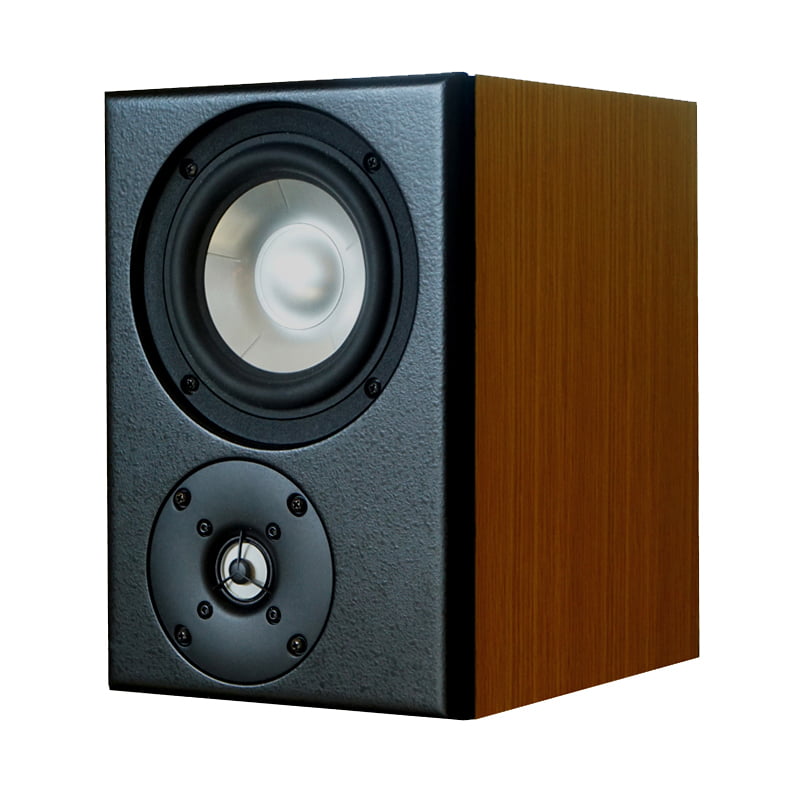Very revealing & highly musical
Since this review, the Kantus have been subject to continuous improvement. Although the outer cabinet shape has remained the same, with its elegant proportions hard to better, further refinement has been produced by improved internal cabinet bracing, internal profiling and constrained-layer damping. They have also been upgraded from a 2.5-way system to a 3.5-way system by adding a dedicated midrange unit – you can read excellent reviews of the Kantu 4s and Kantu 6s on our review page.
Most importantly significantly improved drivers have become available as materials technology has progressed, leading to improved cone breakup and lower distortion of their sound output. At the heart of the new Kantus is the superb 90mm midrange unit also used in our top-of-range Tikandi Grande Bes. It is made from high strength Mg alloy coated on each side with very hard ceramic so that it remains pistonic well above its crossover point. This results in extraordinarily low distortion through the critical mid-band region allowing these vital frequencies to come through crystal clear and without the hardness or muddle of many loudspeakers in this region.
And its excellent tweeter is made of anodised Aluminium alloy – giving the same clarity in the treble. This clarity is maintained by the high-quality crossover using polypropylene capacitors (often in parallel to reduce distortion), air-cored inductors and high-power non-inductive wire-wound resistors, all directly soldered to each other – and to the drivers via a high-quality wire.
The new Kantus also has a low-distortion bass unit made from very strong Aluminium alloy. Together with excellent motor and suspension systems, the ensuing low distortion allows the listener to hear tonal structure in bass notes, again resulting in greater realism of the reproduced music – and not just some homogenised version.
With the new Kantus, we have included the same lens/waveguide as we developed for the Kurres. By narrowing the dispersion of the sound waves at the bottom-end of the tweeter’s range the lens enhances its continuity of dispersion with the top-end of the midrange unit at their crossover frequency, so improving the balance of overall sound (direct + indirect) when passing from mid to treble. The lens/waveguide also improves the phase alignment of mid to treble by moving the tweeter back into the baffle so it is in better time alignment with the midrange. Lastly, it makes the tweeter less vulnerable to damage – and looks even better!
As shown by the attached measurements, because the new Kantus are so accurate with such flat frequency response and low distortion they are very faithful (high ‘fidelity’) and truthful to the music and equipment preceding them in the reproduction chain so will take on the latter’s sound character. If you prefer your music ‘warm or sweet’ then you must partner them with a suitably ‘warm or sweet’ amplifier – perhaps a valve amplifier. Or if you enjoy your music fast & dynamic then choose a suitable fast & dynamic solid-state amplifier. But given the right preceding equipment, you will hear all the emotional drama and nuances of the artists’ playing. Like being there!
A leading recording engineer wrote of the Kantu 9s: “The overall clarity of these is exceptional – particularly the upper mid-band as one of the critical factors I seek is natural voice reproduction – without excessive sibilance or ‘chestiness’. Seems the newly added waveguide is a significant improvement as off-axis dispersion is well maintained.”
In 2019 we improved the mid & treble capacitors and the internal wiring for the Kantu 10s. We received this mail from a customer: “Just a quick note to say that I am very impressed with my Kantu 10s which I purchased recently as an upgrade. The sound is very natural and non-fatiguing and it’s as if the speakers have disappeared to make room for the music which has taken on a new dimension of depth, clarity and power. During my research, I listened to many other speakers at similar price points and beyond, including those from big-name brands, but for me, none of them came close to the Kantu’s. Thank you!”
Yet more recently for the Kantu 12s, we have added a new ceramic-coated aluminium-alloy tweeter that combines the exceptional detail of a metal dome with the smoothness and non-fatiguing characteristic of ceramic. Plus we have realigned the mid to treble Xovers to provide even lower distortion making their reproduction of music even more ‘like being there’!
Frequency Response & Distortion
Finishes
| Overview | 3.5-way bookshelf |
|---|---|
| Configuration | 2xbass + mid + treble |
| Frequency response | 35 – 25,000Hz ± 3 dB; |
| Sensitivity | 88 dB/2.83V @ 1m |
| Impedance | 4 ohms average |
| Recommended power | 50- 300 W |
| Size (mm) | 1050(h) x 200(w) x 300(d) |
| Weight | 35 kg each |
| Finish | Jarrah |
| Warranty | 7 years |













Reviews
There are no reviews yet.